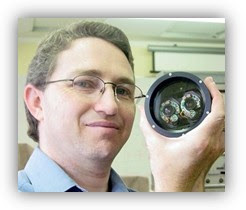Contents
Introduction to 3D Cinema; Why and how do we see 3D?; Managing the switchover to Digital 3D; Introductory workshops; Thinking 3D, or 3D for Storytelling; 3D Art Direction; The 3D Principal Photography; CGI and Visual Effects in 3D; Compositing 3D; Editing 3D; Distributing and Showing 3D; Appendix: 3D Marketplace
Jim here. Recently, there has been a lot of discussion generated by interested students and industry veterans alike that there is a gaping hole in Stereographic 3D formal education. I have had a few prospective students ask: Where should I go to study?
The answer is not so simple. Much of the stereo knowledge lies in industry veterans and in the select few who are now on the leading edge of production - in other words, they are too busy with projects to actually train anyone formally, UNLESS they have "understudies" working with them.
We have a unique situation with a demand that is sure to rise exponentially - just look at the 3D projects coming on stream - Over 20 in 2009! Of course it is supply and demand and right now, stereo experts are definitely in demand. So how do we get around this?
Well I contacted several industry insiders to understand things from their unique perspectives - I spoke with an Actor/Director; Producer; 3D Film Festival Director; 2D to 3D Conversion Experts; a 3D Consultant; and a 3D Supervisor at a Major Animation Studio. I asked them all: "How do we meet this need? Are there courses available right now to talk about, or is everything "picked up on the job"? What can we recommend to someone looking to enter the stereographic 3D field?"

Thomas Jane, Actor / Director THE DARK COUNTRY:
Jim – Good question! I am faced right now with trying to find people... (for some work on THE DARK COUNTRY). ...Thanks for fighting the good 3d fight. TJ
Christopher Crescitelli, Festival Director - The 3D Film & Interactive Festival:
“With 3-D exploding into all areas of entertainment media including film, television, the web, and video games there is already a demand for skilled production technicians, game creators, animators, cinematographers, camera assistants, and post production personnel who can service and support the work flow associated with the creation of content. It is crucial that educational institutions and film programs across the globe begin to embrace 3-D as a viable skill set and begin teaching the early adopters how to use the current tools available to achieve the highest quality of 3-D output so that the industry at large can benefit from a much needed influx of compelling independent and studio supported content.”
“Most of the 3-D artists I have met through the years are people who were self taught through trial and error, or who have been mentored by more seasoned individuals who had already been working in the space. Like most craft industries, 3-D trade secrets must be handed down from a Jedi mentor to a Padawan learner who is passionate about learning to create something that is harder do, more expensive to create, and harder to get distributed.”
 Andrew Woods, Co-Chair of Stereoscopic Displays and Applications conference:
Andrew Woods, Co-Chair of Stereoscopic Displays and Applications conference:"There isn't much out there... However, John Merritt and I run a full day short course on "Stereoscopic Display Application Issues".The course outline is here: www.stereoscopic.org/sc and it runs next on 18 January 2009. The course runs the day before the Stereoscopic Displays and Applications conference starts (and at the same venue) www.stereoscopic.org So the course is a good way of quickly getting up to speed with Stereoscopic 3D Technologies, followed by the conference which is a good way of getting up to speed with the latest developments."
 Neil B. Feldman, EVP Sales, In-Three, Inc.:
Neil B. Feldman, EVP Sales, In-Three, Inc.: "Hi Jim, Great question/issue. As you know, our process, Dimensionalization (2D to 3D conversion), is proprietary. As such, we train all our new employees. Entry level "trainees" do not have to come to us with any prior experience, although if they have some it certainly is a benefit. However, we are great supporters of the concept of creating some new "generic" courses in stereoscopy. -Neil"
 John A. Rupkalvis, Stereoscopic Imaging Consultant, Writer & Educator:
John A. Rupkalvis, Stereoscopic Imaging Consultant, Writer & Educator:
"Jim ~ About four years ago, I was planning on teaching a course on this very subject. It was originally intended as a 6-month program to ultimately be expanded to a 4-year degree program. Unfortunately, the school that was scheduled to offer this course lost their funding and had to close. It was to have been located in China, where there seems to be much more interest in stereoscopic matters than in the U.S. Subsequently, I searched several film schools, including UCLA, Cal Arts, and USC. The general response (when there was one) was that this was a niche that would not have enough interest to support such a course."
Phil McNally, "Captain 3D", Dreamworks Animation
Hi Jim, I think 90% of all stereoscopic knowledge is currently held by the stereo photography clubs. People who have been shooting stereo for years as a fringe hobby. If anyone wants to learn they should find the nearest stereo club. http://www.stereoview.org/3d%20club.htm
As a side note you should know that I contacted UCLA, USC and CalArts for their perspective on things and asking the same questions. I would have posted this at least a week ago, but I chose to give these guys time to get back to me. No response from ANY of them. Unbelievable. Either their disdain is with the modern blogger as a media or their very own students.
I submit that these centers for education should get their act together, discuss with the stereo community what is required and put together some comprehensive courses. There is an obvious need.
In the interim, we have some excellent suggestions from industry experts:
1. Seek out the stereo clubs in your area.
2. Learn on the job as much as possible if you are a coop student or lucky enough to be working with seasoned 3D experts.
3. Pick up as much as you can on your own through Internet resources and books.
4. Learn more about stereo through conferences and tradeshow seminars and programs.
5. In the absence of comment from the universities, I suspect that you could train the basics of your career with them, and then go to the "graduate school of 3D" by working side by side with a "3D Jedi Master" of a going concern.
And keep your eye on your goal - there is plenty of work out there if this is your chosen field, and from the friendly people I talk to on a daily basis - there is plenty of folks willing to help along the way.
If I can be of further assistance to any student, please email me directly at jim (at) marketsaw (dot) com.
 John A. Rupkalvis, Stereoscopic Imaging Consultant, Writer & Educator:
John A. Rupkalvis, Stereoscopic Imaging Consultant, Writer & Educator:"Jim ~ About four years ago, I was planning on teaching a course on this very subject. It was originally intended as a 6-month program to ultimately be expanded to a 4-year degree program. Unfortunately, the school that was scheduled to offer this course lost their funding and had to close. It was to have been located in China, where there seems to be much more interest in stereoscopic matters than in the U.S. Subsequently, I searched several film schools, including UCLA, Cal Arts, and USC. The general response (when there was one) was that this was a niche that would not have enough interest to support such a course."
Phil McNally, "Captain 3D", Dreamworks Animation
Hi Jim, I think 90% of all stereoscopic knowledge is currently held by the stereo photography clubs. People who have been shooting stereo for years as a fringe hobby. If anyone wants to learn they should find the nearest stereo club. http://www.stereoview.org/3d%20club.htm
As a side note you should know that I contacted UCLA, USC and CalArts for their perspective on things and asking the same questions. I would have posted this at least a week ago, but I chose to give these guys time to get back to me. No response from ANY of them. Unbelievable. Either their disdain is with the modern blogger as a media or their very own students.
I submit that these centers for education should get their act together, discuss with the stereo community what is required and put together some comprehensive courses. There is an obvious need.
In the interim, we have some excellent suggestions from industry experts:
1. Seek out the stereo clubs in your area.
2. Learn on the job as much as possible if you are a coop student or lucky enough to be working with seasoned 3D experts.
3. Pick up as much as you can on your own through Internet resources and books.
4. Learn more about stereo through conferences and tradeshow seminars and programs.
5. In the absence of comment from the universities, I suspect that you could train the basics of your career with them, and then go to the "graduate school of 3D" by working side by side with a "3D Jedi Master" of a going concern.
And keep your eye on your goal - there is plenty of work out there if this is your chosen field, and from the friendly people I talk to on a daily basis - there is plenty of folks willing to help along the way.
If I can be of further assistance to any student, please email me directly at jim (at) marketsaw (dot) com.
0 comments:
Post a Comment